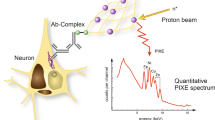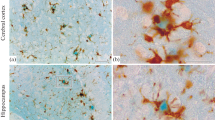Abstract
Quantitative immunogold procedure was used to study the distribution of metallothionein I/II (MT-I/II) at the ultrastructural level in the perivascular areas, including microvascular endothelial cells (ECs) and astrocytes with their perivascular end-feet, in brains of scrapie-infected hyperglycemic (diabetic) and normoglycemic (non-diabetic) mice. Samples of the fronto-parietal cortex obtained from diabetic and non-diabetic scrapie-infected, as well as from non-infected (control) SJL/J mice, were processed for immunocytochemical examination. In control mice, the labelling of the ECs was of low intensity, restricted to few immunogold particles in the cytoplasm. More intense labelling was present in the cytoplasm of astrocytic perivascular processes and perikarya, where it was associated with endoplasmic reticulum and fibrils. A few immunosignals were also present inside the nuclei of astrocytes. In diabetic mice the labelling of the EC cytoplasm was slightly increased, whereas in the cytoplasm of perivascular processes and pericarya of astrocytes, including their nuclei, there was significant enhancement of labelling. In these cells the density of immunosignals was highest in the areas of cytoplasm containing bundles of fibrils. In non-diabetic, scrapie-infected mice the intensity of immunolabelling was higher than in control mice but slightly lower than in diabetic mice. These results are similar to those in Alzheimer’s disease reported by other authors, and suggest that neurodegenerative diseases as well as metabolic stress enhance the metallothionein expression in perivascular regions of brain cerebral cortex, predominantly in astrocytes.


Similar content being viewed by others
References
Apostolova MD, Chen S, Chakrabarti S, Cherian MG (2001) High-glucose-induced metallothionein expression in endothelial cells: an endothelin-mediated mechanism. Am J Physiol Cell Physiol 281:C899–C907
Aschner M (1996) The functional significance of brain metallothioneins. FASEB J 10:1129–1136
Aschner M, Silverman WF, Sekler I, Zatta P (2003) Metallothioneins in Neurodegeneration. In: Zatta P (eds) Metal Ions and Neurodegenerative Disorders. World Scientific, Singapore, pp 308–322
Beltramini M, Di Pisa C, Zambenedetti P, Wittkowski W, Mocchegiani E, Musicco M, Zatta P (2004) Zn and Cu alteration in connection with astrocyte metallothionein I/II overexpression in the mouse brain upon physical stress. Glia 47:30–34
Dandoy-Dromn F, Guillo F, Bendoudjema L, Deslys JP, Lasmezas C, Dormont D, Tovey MG, Dron M (1998) Gene expression in scrapie. Cloning of a new scrapie-responsive gene and the identification of increased levels of seven other mRNA transcripts. J Biol Chem 273:7691–7697
Duguid JR, Rohwer RG, Seed B (1988) Isolation of cDNAs of scrapie-modulated RNAs by subtractive hybridization of a cDNA library. Proc Natl Acad Sci USA 85:5738–5742
Duguid JR, Bohmont CW, Liu NG, Tourtellotte WW (1989) Changes in brain gene expression shared by scrapie and Alzheimer’s disease. Proc Natl Acad Sci USA 86:7260–7264
Dziegiel P, Forgacz J, Suder E, Surowiak P, Kornafel J, Zabel M (2003) Prognostic significance of metallothionein expression in correlation with Ki-67 expression in adenocarcinomas of large intestine. Histol Histopathol 18:401–407
Ebadi M, Babin D (1989) The amino acid composition of the Zinc-induced metallothionein isoforms in rat brain. Neurochem Res 14:69–73
Hazelhoff Roelfzema W, Tohyama C, Nishimura H, Nishimura N, Morselt AFW (1989) Quantitative immunohistochemistry of metallothionein in rat placenta. Histochemistry 90:365–369
Hidalgo J, Campmany L, Marti O, Armario A (1991) Metallothionein-I induction by stress in specific brain areas (1991). Neurochem Res 16:1145–1148
Hidalgo J, Aschner M, Zatta P, Vasak M (2001) Roles of the metallothionein family of proteins in the central nervous system. Brain Res Bull 55:133–145
Liao YJ, Ueno M, Nakagawa T, Huang C, Kanenishi K, Onodera M, Sakamoto H (2005) Oxidative damage in cerebral vessels of diabetic db/db mice. Diabetes Metab Res Rev 21:554–559
Margoshes M, Vallee BL (1957) A cadmium protein from equine kidney cortex. J Am Chem Soc 79:4813–4818
Nishimura H, Nishimura N, Tohyama Ch (1989) Immunohistochemical localization of metallothionein in developing rat tissues. J Histochem Cytochem 37:715–722
Nishimura N, Nishimura H, Ghaffar A, Tohyama Ch (1992) Localization of metallothionein in the brain of rat and mouse. J Histochem Cytochem 40:309–315
Peters A, Palay SF, Webster HF (1976) The fine structure of the nervous system. Saunders Comp, Philadelphia, pp 233–248
Quaife CJ, Findley SD, Erickson JC, Froelick GJ, Kelly EJ, Zambrowicz BP, Palmiter RD (1994) Induction of a new metallothionein isoform (MT-IV) occurs during differentiation of stratified squamous epithelia. Biochemistry 33:7250–7259
Simard M, Arcuino G, Takano T, Liu QS, Nedergaard M (2001) Signaling at the gliovascular interface. J Neurosci 23:9254–9262
Surowiak P, Dziegiel P, Matkowski R, Kornafel J, Wojnar A, Zabel M (2002) Immunocytochemical evaluation of metallothionein (MT) expression in myoepithelial cells of ductal mammary carcinoma and its relation to survival time: analysis of 7-year course of the disease. Folia Histochem Cytobiol 40:199–200
Surowiak P, Matkowski R, Materna V, Gyorffy B, Wojnar A, Pudelko M, Dziegiel P, Kornafel J, Zabel M (2005) Elevated metallothionein (MT) expression in invasive ductal breast cancers predicts tamoxifen resistance. Histol Histopathol 20:1037–1044
Tai SK, Tan OJK, Chow VTK, Jin R, Jones JL, Tan PH, Jajasurya A, Bay BH (2003) Differential expression of metallothionein 1 and 2 isoforms in breast cancer lines with different invasive potential. Am J Pathol 163:2009–2019
Uchida Y, Takio K, Titani K, Ihara Y, Tomonaga M (1991) The growth inhibitory factor that is deficient in the Alzheimer’s disease brain is a 68 amino acid metallothionein-like protein. Neuron 7:337–347
Vorbrodt AW, Dobrogowska DH, Tarnawski M, Meeker HC, Carp RI (1997) Immunocytochemical evaluation of blood–brain barrier to endogenous albumin in scrapie-infected mice. Acta Neuropathol 93:341–348
Vorbrodt AW, Dobrogowska DH, Tarnawski M, Meeker HC, Carp RI (2001) Quantitative immunogold study of glucose transporter (GLUT-1) in five brain regions of scrapie-infected mice showing obesity and reduced glucose tolerance. Acta Neuropathol 102:278–284
Vorbrodt AW, Dobrogowska DH, Tarnawski M, Meeker HC, Carp RI (2006) Immunogold study of altered expression of some interendothelial junctional molecules in the brain blood microvessels of diabetic scrapie-infected mice. J Mol Hist 37(1-2):27–35
Yamada M, Hayashi S, Hozumi I, Inuzuka T, Tsuji S, Takahashi H (1996) Subcellular localization of growth inhibitory factor in rat brain: light and electron microscopic immunohistochemical studies. Brain Res 735:257–264
Yang J, Cherian MG (1994) Protective effects of metallothionein on streptozotocin-induced diabetes in rats. Life Sci 55:43–51
Zambenedetti P, Giordano R, Zatta P (1998) Metallothioneins are highly expressed in astrocytes and microcapillaries in Alzheimer’s disease. J Chem Nauroanat 15:21–26
Zatta P, Zambenedetti P, Stella MP, Licastro F (2002) Astrocytosis, microgliosis, metallothionein-I-II and amyloid expression in high cholesterol-fed rabbits. J Alzheimer’s Dis 4:1–9
Zatta P, Zambenedetti P, Musicco M, Adorni F (2005) Metallothionein-I-II and GFAP positivity in the brains from frontotemporal dementia patients. J Alzheimer’s Dis 8:109–116
Acknowledgements
The authors wish to express their appreciation to Ms J. Kay for secretarial assistance. This work was supported by the New York State Office of Mental Retardation and Developmental Disabilities.
Author information
Authors and Affiliations
Corresponding author
Rights and permissions
About this article
Cite this article
Vorbrodt, A.W., Dobrogowska, D.H., Meeker, H.C. et al. Quantitative immunogold study of increased expression of metallothionein-I/II in the brain perivascular areas of diabetic scrapie-infected mice. J Mol Hist 37, 143–151 (2006). https://doi.org/10.1007/s10735-006-9053-6
Received:
Accepted:
Published:
Issue Date:
DOI: https://doi.org/10.1007/s10735-006-9053-6




